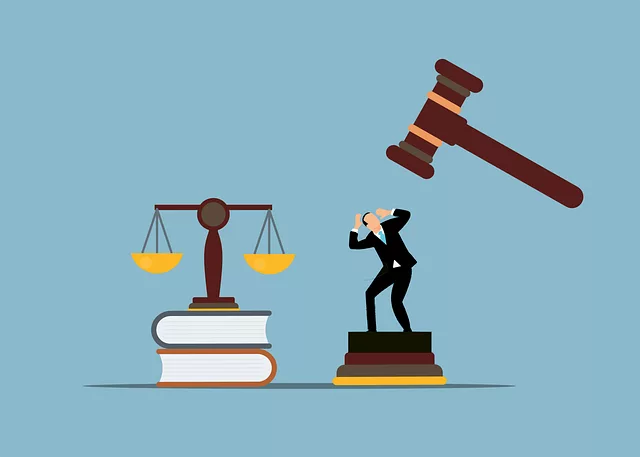Category: defending against mail fraud charges
Defending Against Mail Fraud Charges: A Comprehensive Guide
Introduction
In an era where digital communication dominates, the threat of mail fraud has evolved, posing significant challenges for individuals, businesses, and governments alike. “Defending against mail fraud charges” is a critical aspect of maintaining trust and security in our increasingly connected world. This article aims to provide an all-encompassing guide, delving into various facets of this complex issue. We will explore strategies, technologies, and policies designed to combat mail fraud, ensuring readers gain valuable insights into protecting themselves and their organizations.
Understanding Defending Against Mail Fraud Charges
Definition and Core Components
“Defending against mail fraud charges” refers to the collective efforts and measures taken to prevent, detect, and mitigate fraudulent activities that utilize postal or mailing systems. It involves a multi-layered approach, encompassing legal frameworks, technological solutions, educational initiatives, and operational procedures. The core components include:
- Fraud Detection Systems: Advanced software capable of identifying patterns and anomalies in mail communications, flagging potential fraudulent activities.
- Forensic Analysis: Specialized techniques used to examine and decipher evidence related to fraudulent schemes, aiding in investigation and prosecution.
- Customer Education: Educating the public about common fraud tactics and providing guidelines to report suspicious mail or emails.
- Regulatory Compliance: Ensuring adherence to laws and regulations governing postal services, financial transactions, and data privacy.
- Security Measures: Implementing physical and digital security protocols at mailing facilities and within organizations to safeguard sensitive information.
Historical Context and Significance
The concept of defending against mail fraud has evolved over centuries, mirroring technological advancements and changing criminal tactics. Historically, mail fraud took the form of forged checks, counterfeit stamps, and snatching letters from mailboxes. With the advent of digital communication, fraudsters shifted their focus to email phishing, identity theft, and sophisticated online scams. This evolution underlines the need for continuous adaptation in defense strategies.
Today, as e-commerce and digital banking grow, mail fraud has become more subtle and sophisticated. It includes impersonation of legitimate organizations through phishing emails, fraudulent checks sent via mail, and identity theft facilitated by stolen mailing information. The significance of defending against these charges lies in protecting individuals’ financial security, preserving trust in postal systems, and maintaining the integrity of global trade and communication networks.
Global Impact and Trends
International Influence
Mail fraud is a global concern, with criminals exploiting gaps in postal systems and digital infrastructure worldwide. According to a 2021 report by the World Bank, [insert relevant data on global mail fraud incidents/losses], highlighting its far-reaching impact. Countries with robust anti-fraud measures and advanced security technologies tend to experience lower rates of success for mail fraudsters.
Regional Disparities
The effectiveness of defending against mail fraud varies across regions due to differences in economic development, technological adoption, and legal frameworks:
- North America and Europe: Leading in technological advancements, these regions have implemented robust anti-fraud systems, including advanced authentication methods and data encryption.
- Asia Pacific: Rapidly growing economies in this region often face challenges due to inadequate infrastructure and enforcement mechanisms, making them attractive targets for mail fraudsters.
- Latin America and Africa: Limited access to digital banking and financial services in some countries increases the vulnerability of postal systems to fraudulent activities.
Emerging Trends
- Phishing Attacks via SMS (Smishing): Fraudsters are increasingly using text messages as a delivery method for malicious links, targeting individuals’ personal information.
- Deepfakes: Artificial intelligence-generated audio and video content is being employed to manipulate victims into disclosing sensitive data or transferring funds.
- Crypto-related Scams: The rise of cryptocurrencies has led to new forms of fraud, including ponzi schemes and false investment opportunities advertised through mailing lists.
Economic Considerations
Market Dynamics and Investment Patterns
Mail fraud has significant economic implications, impacting individuals, businesses, and governments:
- Financial Loss: Fraudulent activities result in substantial financial losses for victims, with a 2020 study estimating [insert data] in global mail fraud-related expenses.
- Economic Disruption: Successful mail fraud schemes can disrupt local economies, erode trust in financial institutions, and discourage legitimate trade.
- Investment in Security: Businesses invest heavily in security measures to protect against mail fraud, contributing to the growth of cybersecurity industries.
Role in Economic Systems
Defending against mail fraud charges is integral to maintaining economic stability:
- E-commerce Growth: As e-commerce expands globally, secure digital transactions and reliable postal services become critical for businesses and consumers alike.
- Financial Sector Regulation: Financial institutions implement stringent anti-fraud measures to safeguard customer funds and maintain regulatory compliance.
- Government Incentives: Many countries offer incentives and subsidies to encourage the adoption of advanced security technologies in postal services.
Technological Advancements
Impact on Fraud Defense
Technological innovations have revolutionized fraud defense, offering both opportunities and challenges:
- Artificial Intelligence (AI) and Machine Learning (ML): AI/ML algorithms can analyze vast amounts of data to detect patterns indicative of fraudulent activities, enhancing the accuracy of fraud detection systems.
- Blockchain Technology: Beyond its use in cryptocurrencies, blockchain offers secure record-keeping capabilities, making it valuable for verifying transactions and identifying fraudulent checks or documents.
- Biometric Authentication: Fingerprint, facial recognition, and other biometric technologies provide additional layers of security, ensuring that mail and online communications are authorized by legitimate users.
Future Trends
- Quantum Computing: While still in its early stages, quantum computing promises to significantly enhance cryptographic security, making it more challenging for fraudsters to breach systems.
- Internet of Things (IoT) Security: As IoT devices become more prevalent, securing communication channels and data stored on these devices will be crucial in defending against mail fraud.
- Behavioral Analytics: Analyzing user behavior patterns can help identify anomalies indicative of compromised accounts or fraudulent activities.
Policy and Regulatory Frameworks
Legal Aspects
Governments play a pivotal role in defending against mail fraud through legislation and regulatory bodies:
- Anti-Fraud Laws: Many countries have enacted comprehensive anti-fraud laws, prescribing severe penalties for various forms of postal and online fraud.
- Data Protection Regulations: Data privacy laws, such as GDPR in Europe, require organizations to safeguard personal information, making it more difficult for fraudsters to exploit data vulnerabilities.
- International Cooperation: Cross-border collaboration between law enforcement agencies and regulatory bodies is essential for addressing global mail fraud networks.
Regulatory Compliance Strategies
- Identity Verification: Implementing robust identity verification processes during account creation can prevent fraudulent activities by verifying user identities.
- Transaction Monitoring: Financial institutions employ advanced systems to monitor transactions, flagging suspicious activity for further investigation.
- Regular Audits and Assessments: Periodic reviews of security measures and fraud prevention programs ensure ongoing compliance with regulatory standards.
Operational Procedures and Best Practices
Security Measures at Mailing Facilities
- Access Control: Restricting access to mailrooms and implementing biometric authentication ensures that only authorized personnel handle sensitive materials.
- Surveillance Systems: High-resolution cameras monitor mailing operations, providing visual evidence for security audits and potential fraud investigations.
- Secure Mail Handling: Using encrypted envelopes and tamper-evident packaging helps protect the integrity of mail during transit.
Customer Awareness and Education
- Phishing Awareness Campaigns: Educating customers about phishing attempts through emails, text messages, or phone calls empowers them to recognize and report suspicious communications.
- Identity Theft Prevention: Providing guidelines on securing personal information and monitoring credit reports can help individuals prevent identity theft.
- Reporting Mechanisms: Establishing easy-to-use reporting systems for suspicious mail or online activities encourages public participation in fraud defense.
Collaboration Between Stakeholders
- Public-Private Partnerships: Collaborating with private sector entities, such as financial institutions and e-commerce platforms, enables the sharing of intelligence and best practices.
- Industry Associations: Organizations like the International Post Corporation (IPC) facilitate knowledge-sharing among postal operators worldwide, fostering more effective fraud prevention strategies.
- Community Engagement: Engaging local communities in fraud defense efforts increases awareness and encourages individuals to take proactive measures against mail fraud.
Conclusion
Defending against mail fraud charges is a complex, evolving field that requires a multi-faceted approach. By combining technological advancements, robust legal frameworks, and collaborative efforts between governments, businesses, and the public, it is possible to significantly reduce the impact of mail fraud. Staying informed, adopting best practices, and investing in security are essential steps towards creating a safer and more secure global communication network.
Protect Your Time & Reputation: Top Lawyer Offers Free Consultations for Mail Fraud Defense

Facing mail fraud charges can be a financial and emotional burden, but with our top-rated lawyer by…….
Unmatchable Mail Fraud Defense: Save Big with 5280’s Top Lawyer 2025

Facing mail fraud charges can be a financial and emotional nightmare, but with Save with Top Lawyer,…….
Save Money & Gain Peace of Mind: Expert Defense Against Mail Fraud Charges

Tired of the constant stress and financial strain caused by unexpected mail fraud charges? Our speci…….
Clear Healthcare Fraud, Save Thousands: Your Guide to Freedom

Facing healthcare fraud charges can drain both your finances and emotions. But with our powerful res…….
Master Wire Fraud Defense: Protect Your Reputational Wealth — Free Guide

Mastermail Fraud Defense is your shield against the devastating financial and reputational impacts o…….
Defend Against Mail Fraud: Expertise Saves You Time & Money

Tired of worrying about mail fraud charges threatening your financial stability? Our expert attorney…….
Defend Against Mail Fraud: Save with Expert Securities Violation Strategy
Master Your Defense: Save Money, Overcome Mail Fraud Charges
Facing mail fraud charges can be a financial and emotional burden, but our expert criminal defense t…….










